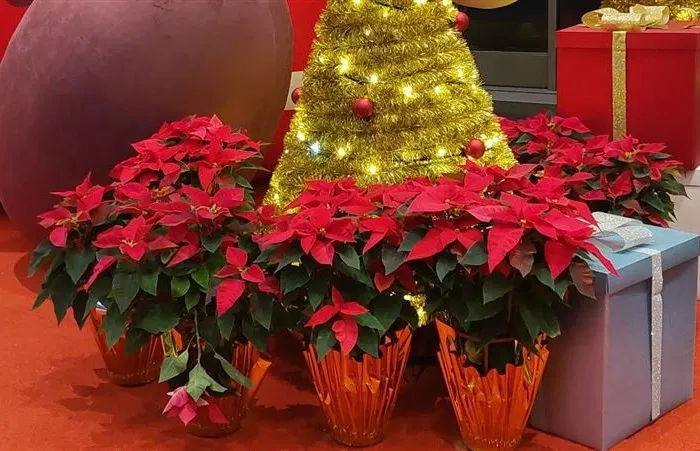The poinsettia is widely recognized as the quintessential Christmas flower, adorning homes, churches, and public spaces during the holiday season. Its vibrant red and green foliage embodies the spirit of Christmas and has become a symbol of festive joy, hope, and faith. But why exactly is the poinsettia so strongly associated with Christmas? What is the origin of this tradition, and what deeper meanings does the poinsettia hold within the context of Christian celebrations?
The story of the poinsettia’s connection to Christmas is as rich and vibrant as the plant itself. Originating in Mexico, the poinsettia—known locally as “Flor de Nochebuena” (Christmas Eve Flower)—has a long history tied to Mexican culture, indigenous traditions, and early Christian symbolism. The plant’s rise to prominence as a Christmas emblem reflects a fascinating blend of natural beauty, cultural storytelling, and religious significance that has been embraced worldwide.
In exploring the poinsettia’s role as a Christmas flower, it is essential to delve into its botanical origins, historical journey to becoming a holiday staple, and the symbolic meanings attributed to its colors and form. The striking red bracts and lush green leaves symbolize important Christian themes such as the blood of Christ, eternal life, and renewal. This symbolism has been further amplified by Christmas devotionals and celebrations that use the poinsettia to inspire reflection on Christ’s sacrifice and joyous birth.
Moreover, the poinsettia’s seasonal bloom during winter ties it naturally to the Christmas season, making it an ideal decorative and devotional element. The plant’s association with Christmas is not merely ornamental; it is woven into the spiritual fabric of the holiday through stories, sermons, and practices that highlight its significance.
This introduction serves as a foundation for a comprehensive understanding of why the poinsettia is known as the Christmas flower. Through exploring its historical origins, cultural impact, theological symbolism, and modern-day use in celebrations, we uncover how this beautiful plant has transcended its botanical identity to become a meaningful icon of Christmas.
The journey of the poinsettia from the wilds of Mexico to the centerpiece of Christmas décor worldwide is a story of faith, culture, and nature coming together. It is a story that invites believers and admirers alike to appreciate the deeper messages conveyed through this flower during the Christmas season. The poinsettia reminds us of hope in darkness, the joy of giving, and the beauty of God’s creation celebrated during Christmas.
The Botanical Origins of the Poinsettia
The poinsettia, scientifically known as Euphorbia pulcherrima, is native to the tropical regions of Mexico and Central America. It thrives in warm climates and blooms naturally during the winter months, coinciding with the Christmas season. Its red “petals” are actually bracts—modified leaves—that surround small, yellow flowers in the center.
The indigenous peoples of Mexico were familiar with the poinsettia long before European contact. They used the plant for various ceremonial purposes and as a natural dye. Its striking red color was associated with vitality and life, concepts that resonate deeply with Christian symbolism.
The Legend of the Poinsettia and Christmas Eve
One popular Mexican legend tells of a poor girl named Pepita who wanted to bring a gift to the Christ child at Christmas but had nothing to offer. Inspired by an angel, she gathered humble weeds from the roadside and placed them at the church altar. Miraculously, the weeds transformed into vibrant red poinsettias, symbolizing the power of sincere faith and humble giving.
This story helped cement the poinsettia’s connection to Christmas, highlighting themes of sacrifice, love, and transformation. It also contributed to the plant’s nickname, “Flor de Nochebuena.”
Joel Roberts Poinsett and the Introduction to the United States
The poinsettia gained international recognition thanks to Joel Roberts Poinsett, the first U.S. ambassador to Mexico in the 1820s. Fascinated by the plant, he sent specimens back to the U.S., where it was cultivated and eventually popularized as a Christmas decoration.
Today, December 12th is celebrated in the U.S. as National Poinsettia Day in honor of Poinsett’s role in bringing the plant to American awareness.
Symbolism of the Poinsettia in Christian Tradition
The red bracts of the poinsettia symbolize the blood of Jesus Christ shed on the cross, while the green leaves represent eternal life. Together, these colors reflect the core Christian message of salvation and hope.
In many churches, poinsettias are used to decorate altars during Christmas services, reminding congregations of the significance of Christ’s birth and sacrifice. The star-shaped leaf pattern is often seen as a representation of the Star of Bethlehem, guiding the Wise Men to Jesus.
The Poinsettia in Christmas Devotionals and Worship
Throughout the Christmas season, many believers incorporate the poinsettia into their devotionals and worship practices. It serves as a tangible reminder of God’s love and the miracle of the incarnation.
For those seeking daily spiritual inspiration during the holiday season, Christmas Devotionals often include reflections on the poinsettia’s symbolism and its call to faith and gratitude.
Global Adoption and Modern Traditions
Beyond Mexico and the United States, the poinsettia has become a beloved Christmas symbol worldwide. Its image is found in decorations, greeting cards, and holiday marketing. The flower’s popularity underscores how cultural and spiritual meanings can transcend borders, uniting diverse peoples in celebration.
Conclusion
The poinsettia is more than just a beautiful holiday plant—it is a powerful symbol of faith, hope, and transformation. Its journey from Mexican tradition to global Christmas icon reflects the ways nature, culture, and spirituality intertwine to enrich our celebrations.
By understanding why the poinsettia is known as the Christmas flower, we gain deeper insight into the holiday’s spiritual heart. The poinsettia invites us to embrace the humble gifts of faith, to celebrate the light that Christ brings into the world, and to share joy with those around us.
As we display poinsettias each Christmas, we participate in a living tradition that honors both the past and the present, reminding us of the enduring meaning of the season.
Related topics:

